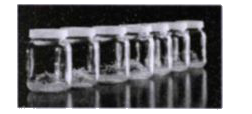The rate of growth of bacteria is proportional to the number present . If initially, there were 1000 bacteria and the number doubles in 1 hours. Find the number of bacteria after 212 hours . [ take √2=1.414]
To solve the problem of bacterial growth, we will follow these steps:
Step 1: Set up the differential equation
The rate of growth of bacteria is proportional to the number present. We can express this as:
dndt=kn
where n is the number of bacteria, t is time, and k is the proportionality constant.
Step 2: Separate variables and integrate
We can rearrange the equation to separate the variables:
dnn=kdt
Now, we integrate both sides:
∫dnn=∫kdt
This gives us:
lnn=kt+C
where C is the constant of integration.
Step 3: Solve for the constant of integration
We know that initially (at t=0), there were 1000 bacteria:
ln(1000)=k(0)+C⟹C=ln(1000)
So, our equation becomes:
lnn=kt+ln(1000)
Step 4: Rewrite the equation
We can rewrite the equation using properties of logarithms:
lnn−ln(1000)=kt⟹ln(n1000)=kt
Exponentiating both sides gives:
n1000=ekt⟹n=1000ekt
Step 5: Find the value of k
We are given that the number of bacteria doubles in 1 hour. Therefore, when t=1:
n=2000(since it doubles from 1000)
Substituting into the equation:
2000=1000ek(1)⟹2=ek⟹k=ln(2)
Step 6: Substitute k back into the equation
Now we substitute k back into our equation for n:
n=1000e(ln(2))t
This simplifies to:
n=1000⋅2t
Step 7: Find the number of bacteria after 2.5 hours
Now we need to find n when t=2.5:
n=1000⋅22.5
We can express 22.5 as:
22.5=22⋅20.5=4⋅√2
Substituting this back:
n=1000⋅4⋅√2=4000⋅√2
Step 8: Substitute the value of √2
Given √2=1.414:
n=4000⋅1.414=5656
Final Answer
Thus, the number of bacteria after 2.5 hours is approximately:
5656
The rate of growth of bacteria is proportional to the number present. We can express this as:
dndt=kn
where n is the number of bacteria, t is time, and k is the proportionality constant.
We can rearrange the equation to separate the variables:
dnn=kdt
Now, we integrate both sides:
∫dnn=∫kdt
This gives us:
lnn=kt+C
where C is the constant of integration.
We know that initially (at t=0), there were 1000 bacteria:
ln(1000)=k(0)+C⟹C=ln(1000)
So, our equation becomes:
lnn=kt+ln(1000)
We can rewrite the equation using properties of logarithms:
lnn−ln(1000)=kt⟹ln(n1000)=kt
Exponentiating both sides gives:
n1000=ekt⟹n=1000ekt
We are given that the number of bacteria doubles in 1 hour. Therefore, when t=1:
n=2000(since it doubles from 1000)
Substituting into the equation:
2000=1000ek(1)⟹2=ek⟹k=ln(2)
Now we substitute k back into our equation for n:
n=1000e(ln(2))t
This simplifies to:
n=1000⋅2t
Now we need to find n when t=2.5:
n=1000⋅22.5
We can express 22.5 as:
22.5=22⋅20.5=4⋅√2
Substituting this back:
n=1000⋅4⋅√2=4000⋅√2
Given √2=1.414:
n=4000⋅1.414=5656
Thus, the number of bacteria after 2.5 hours is approximately:
5656
Topper's Solved these Questions
- BOOK - NAVNEET PUBLICATION - MAHARASHTRA BOARDCHAPTER - DIFFERENTIAL EQUATIONS EXERCISE - Examples for practice15videos
DIFFERENTIAL EQUATIONS
- BOOK - NAVNEET PUBLICATION - MAHARASHTRA BOARDCHAPTER - DIFFERENTIAL EQUATIONS EXERCISE - Examples for practice (2)18videos
DIFFERENTIAL EQUATIONS
- BOOK - NAVNEET PUBLICATION - MAHARASHTRA BOARDCHAPTER - DEFINITE INTEGRALSEXERCISE - MULTIPLE CHOICE QUESTIONS10videos
DEFINITE INTEGRALS
- BOOK - NAVNEET PUBLICATION - MAHARASHTRA BOARDCHAPTER - DIFFERENTIATIONEXERCISE - MCQ15videos
DIFFERENTIATION
Similar Questions
Knowledge Check
- Question 1 - Select One
The rate of increase in the number of bacteria in a certain bacteria culture is proportional to the number present. If in 5 hrs the number triples, then in 10 hrs, the number of bacteria present is
A18 times the originalB12 times the originalC6 times the originalD9 times the original - Question 2 - Select One
Read the following text and answer the following questions on the basis of the same: The rate of increase in the number of bacteria in a certain bacteria culture is proportional to the number present. Given that the number triples in 5 hours.

If N0 is the initial count of bacteria, after 10 hours the count is __________ .A15log3B3logN0C9N0D2N0 - Question 3 - Select One
The rate of increase in the number of bacteria in a certain becteria culture is propotional to the number present at that time. If initiallly there are 300 bacteria and after 2 hours, the bacteria polulation is increased by 20% then after 24 houre, the number of bacteria are (log1.2=0.18232,e2.18784=8.9166)
A2675B2674C3210D3209
Bacteria increases at the rate proportional to the number of bacteria present. If the original number N doubles in 3 hours, find in how many hours the number of bacteria will by 4N ?
View SolutionThe rate of increase of the bacteria in a culture is proportional to the number of bacteria present and it is found that the number doubles in 6 hours. Prove that the bacteria becomes 8 times at the end of 18 hours.
View SolutionThe rate of increases of bacteria in a certain culture is proportional to the number present. If it doubles in 5 hr., then in 25 hr., its number would be
View SolutionRead the following text and answer the following questions on the basis of the same: The rate of increase in the number of bacteria in a certain bacteria culture is proportional to the number present. Given that the number triples in 5 hours.

If 'N' is the number of bacteria, the corresponding differential equation is ____________ .View SolutionThe rate of increase in the number of bacterai in a certain becteria culture is propotional to the number present at that time. If is found that the number doubles in 4 hours, then at the end of 12 hours, the number of bacteria are
View Solution

